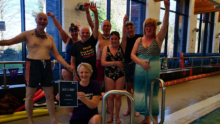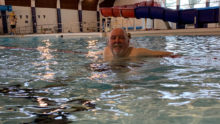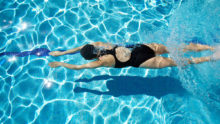
Mindfulness techniques to try in the pool
08/10/2018Swim England qualified Coach, Lucy Lloyd-Roach shares her experiences of how swimming has helped her mindfulness, and shares techniques for you to try.
Meditation and swimming
It was five years ago, as mindfulness started to creep onto the periphery of our collective consciousness that I began to wonder if from what people said about meditation and mindfulness that it described the mind-set I experienced after a swim. I was intrigued to find out if they were the same.
Before exploring it, the phrases that I associated with mindfulness and meditation were ‘a clear head’ and ‘reduced stress’. These are things that I can remember starting to notice after swims when I was at secondary school, I’d often work out the answer to something or just feel much calmer.
Mindfulness is commonly described as a simple form of mediation or mind training.
For me, mindfulness is a way of learning to be aware and observe your thoughts (both good and bad) with the aim of not getting caught up and being non-judgemental about them (some days this is easier than others). It’s a chance to step back, learn more about yourself and how your mind works.
Similarities between swimming and mindfulness
As I become more practised, I discovered that the effects are similar to how I felt after a swim, and for me, it’s due to the two main similarities between both activities:
- Breathing
The type of meditation that I learned focuses on breathing and in swimming, breathing is absolutely key. I see this from a coaching point of view, the swimmer who isn’t exhaling properly often fatigues quickly or feels panicky. - Focus on what you’re currently doing
When you swim, there are no other distractions, a rarity in this digital age and we just focus on technique, or times, or the distance we’re swimming i.e. we’re focused on what we’re doing.
I’ve found that mindfulness has helped my swimming and swimming has helped my mindfulness, which both in turn help me in everyday life.
Mindfulness techniques to try next time you go swimming
Breathing
- On front crawl you can count and say out loud your breathing pattern into the water e.g. ‘One’, ‘two’, ‘three’. As you say it out loud, you’ll actually exhale into the water.
- Swim 200m front crawl, breathing every three strokes for the first 50m, breathe every four strokes to the left for 50m, breathe every five strokes for 50m and finally breathe every four to the right for 50m. Aim for a smooth continual exhalation. If breathing every five strokes is too challenging, switch to breathing everything three strokes on the third 50m.
- Slow it down – focus on long stretched arm and leg movements rather than making your swim a frantic race.
Technique
- Focus on one key part of your technique, e.g. a strong kick together on breaststroke. As you swim, the brain will start to switch focus to this rather what else it’s been focused on within every day life.
Counting strokes
- Try counting the number of strokes per length. What do you notice about your technique? Does it feel the same throughout the length? Does it change from the start to the end of your swim?
 Just Swim
Just Swim



